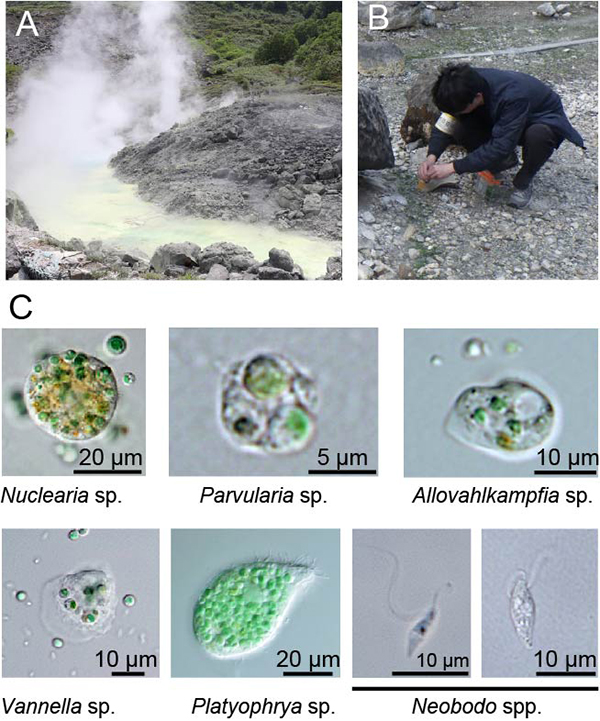Discovery of diverse eukaryotes adapted to high-temperature and acidic environments
Miyagishima Group / Symbiosis and Cell Evolution Laboratory
Heterotrophic unicellular eukaryotes feeding on the unicellular red alga Cyanidiococcus sp. in moderately hot geothermal sulfuric springs
Yuki Sunada, Dai Tsujino, Shota Yamashita, Wei-Hsun Hsieh, Kei Tamashiro, Jin Izumi, Fumi Yagisawa, Baifeng Zhou, Shunsuke Hirooka, Takayuki Fujiwara, Shin-ya Miyagishima
FEMS Microbiology Ecology (2025) 101, Article fiaf048, DOI:10.1093/femsec/fiaf048
Sulfuric acidic hot springs (<pH 4.0, >37°C) are found in volcanic regions worldwide, where various bacteria, archaea, and the unicellular red algae Cyanidiophyceae dominate. Regarding heterotrophic eukaryotes, the only known species was the thermophilic amoeboflagellate Tetramitus thermacidophilus (class Eutetramitea, phylum Heterolobosea), which feeds on surrounding bacteria and archaea. In this study, we investigated three sulfuric hot springs (34.7–50°C, ~pH 2.0) in Japan to determine whether other heterotrophic eukaryotes inhabit these environments. As a result, we isolated and identified cultures of four species capable of surviving at pH 2.0 and 40°C: Allovahlkampfia sp. (Eutetramitea, Heterolobosea); Nuclearia sp. and Parvularia sp (Nucleariidea, Cristidiscoidea); and Vannella sp. (Discosea, Amoebozoa). Phylogenetic analyses suggest that these four species independently evolved from mesophilic and neutrophilic ancestors, separate from each other. Additionally, Platyophrya sp. (Colpodea, Ciliophora) and two species of Neobodo (Euglenozoa, Kinetoplastea) were also found in the same environment, while their maximum survival temperatures were 35°C and 30°C, respectively. Among these, all species except Neobodo were confirmed to grow exclusively by feeding on Cyanidiococcus sp., a dominant species of Cyanidiophyceae in the environment. Thus, various lineages of heterotrophic unicellular eukaryotes have independently developed acidophilic and thermotolerant traits, allowing them to colonize sulfuric hot springs.

Figure: Unicellular eukaryotes isolated and cultured from a sulfuric acidic hot spring
(A) The environment of a sulfuric acidic hot spring; (B) Mr. Sunada collecting samples on site; (C) Microscopic images of unicellular eukaryotes discovered and successfully cultured in this study (the green structures inside the cells are microalgae Cyanidiophyceae being ingested and digested intracellularly).















